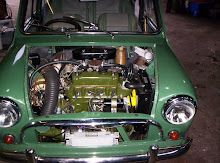The S.U. carburettor is not very sensitive to minor changes in fuel level but it must be remembered that the life of the float-operated needle valve that controls the flow of fuel from the petrol pump and shuts off the supply when the petrol level in the float chamber bowl reaches the correct height, is not unlimited. Vibration and move¬ment of the valve on its seating inevitably cause wear, resulting in an over-rich mixture and flooding. To check the valve, switch on the ignition and allow the fuel pump to fill the float chamber. If the pump then continues to click at intervals and petrol eventually begins to drip from the carburettor, the needle valve is faulty.
2.- Fast-idle connecting link
3. Screw retaining link
4. Return spring
5. Bush
6. Sleeve nut
7. Flexible jet tube
8. Float chamber
9. Carburettor body
10. Gland
11. Washer
12. Ferrule
13. Jet-adjusting nut
14. Spring for nut
15. Jet bearing
16. Brass washer
17. Jet bearing locking-nut
18. Piston key
The float chamber can be removed by unscrewing the retaining bolt and the feed tube union. Remove the lid, tip out the float and swill any sedi¬ment out of the base of the float chamber. The nee. le valve should be unscrewed from the lid of the float chamber and swilled in petrol to remove any grit or sediment. If, after reassembling the carburettor, flooding persists, a new valve should be fitted.
While the float-chamber lid is off, two other items should be checked. The float may be dented or may have developed a slight leak, in which case fuel can be heard swilling about inside it when it is shaken. Un¬doubtedly the best plan is to fit a new float, although a perforated metal float can be repaired by immersing it in hot water until bubbles cease to emerge from the point at which leakage is occurring, and then sealing the leak with a thin film of solder.
The second point to check is the pivoted fork that rests on the float and operates the needle valve. If this has been bent too far towards the float-chamber lid the petrol level will be too high. Conversely, of course, if the prongs of the fork have been bent downwards too far the petrol supply will be shut off before the correct level is reached. The fork should be adjusted so that when the shank is resting on the needle valve, it is just possible to slide a ^ in. diameter bar, such as the shank of a twist drill, between the prongs and the lip of the lid. The prongs of the lever must be slightly curved and should rest squarely on the test bar, while the section between the prongs and the pivot must be perfectly straight and flat.


0 comments:
Post a Comment